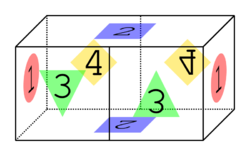Hantzsche–Wendt manifold
The Hantzsche–Wendt manifold, also known as the HW manifold or didicosm,[1] is a compact, orientable, flat 3-manifold, first studied by Walter Hantzsche and Hilmar Wendt in 1934.[2] It is the only closed flat 3-manifold with first Betti number zero. Its holonomy group is [math]\displaystyle{ \mathbb{Z}_2^2 }[/math].[3] It has been suggested as a possible shape of the universe because its complicated geometry can obscure the features in the cosmic microwave background that would arise if the universe is a closed flat manifold, such as the 3-torus.[4]
Construction

The HW manifold can be built from two cubes that share a face. One construction proceeds as follows:[5]
- The top and bottom faces are glued to one another.
- One of the remaining sides is glued to the opposite side with a 180° rotation.
- One of the remaining faces on the top cube is glued to the matching face of the bottom cube, reflected across an axis parallel to the long axis of the double-cube.
- Repeat step 3 for the remaining pair of faces.
Generalizations
In addition to the orientable one (the Hantzsche–Wendt manifold), there are two non-orientable flat 3-manifolds with holonomy group [math]\displaystyle{ \mathbb{Z}_2^2 }[/math], known as the first and second amphidicosms, both with first Betti number 1.[1]
Similar flat n-dimensional manifolds with holonomy [math]\displaystyle{ \mathbb{Z}_2^{n-1} }[/math], known as generalized Hantzsche–Wendt manifolds, may be constructed for any n≥2, but orientable ones exist only in odd dimensions.[1] The number of orientable HW manifolds up to diffeomorphism increases exponentially with dimension.[3] All of these have first Betti number β1 0 or 1.[1]
Trivia
The didicosm is eponymous and plays a central role in Greg Egan's science-fiction short story didicosm.
References
- ↑ Jump up to: 1.0 1.1 1.2 1.3 1.4 Rossetti, Juan P.; Szczepański, Andrzej (2005). "Generalized Hantzsche-Wendt flat manifolds". Revista Matemática Iberoamericana 21 (3): 1053–1070. doi:10.4171/RMI/445. https://ems.press/content/serial-article-files/4973.
- ↑ Hantzsche, Walter; Wendt, Hilmar (1935). "Dreidimensionale euklidische Raumformen". Mathematische Annalen 110 (1): 593–611. doi:10.1007/bf01448045. ISSN 0025-5831. http://dx.doi.org/10.1007/bf01448045.
- ↑ Jump up to: 3.0 3.1 Miatello, R. J.; Rossetti, J. P. (29 October 1999). "Isospectral Hantzsche-Wendt manifolds" (in en). Journal für die reine und angewandte Mathematik (Crelle's Journal) 1999 (515): 1–23. doi:10.1515/crll.1999.077. ISSN 1435-5345. https://www.degruyter.com/document/doi/10.1515/crll.1999.077/html.
- ↑ Aurich, R; Lustig, S (21 August 2014). "The Hantzsche–Wendt manifold in cosmic topology". Classical and Quantum Gravity 31 (16): 165009. doi:10.1088/0264-9381/31/16/165009. ISSN 0264-9381. Bibcode: 2014CQGra..31p5009A. https://iopscience.iop.org/article/10.1088/0264-9381/31/16/165009.
- ↑ Jump up to: 5.0 5.1 Demianski, Marek (2003). "Topology of the universe and the cosmic microwave background radiation". in Sanchez, Norma. The early universe and the cosmic microwave background: theory and observations. Dordrecht: Kluwer Academic Publishers. pp. 166–169. ISBN 978-1-4020-1800-8.
 |

